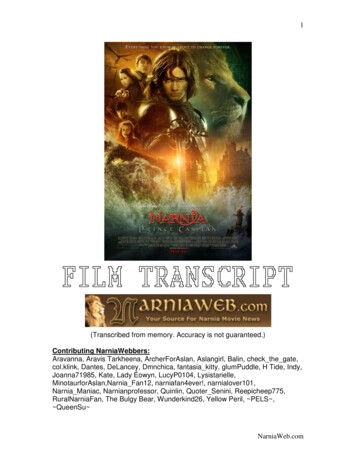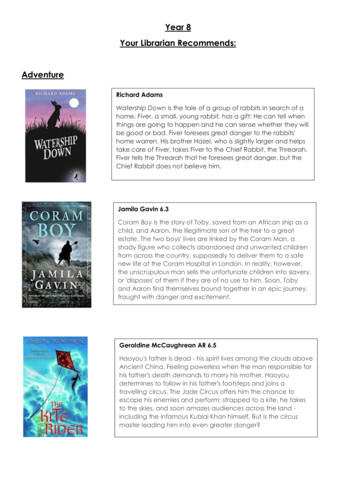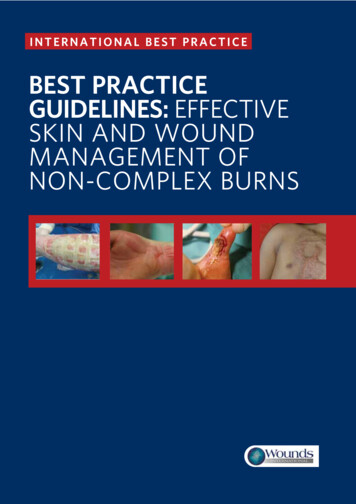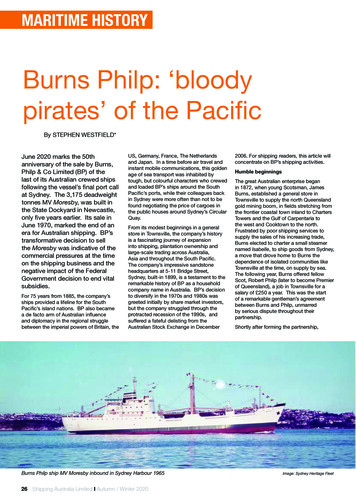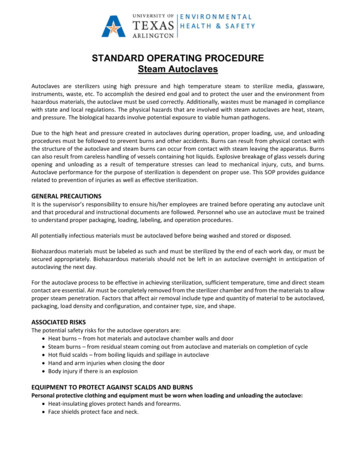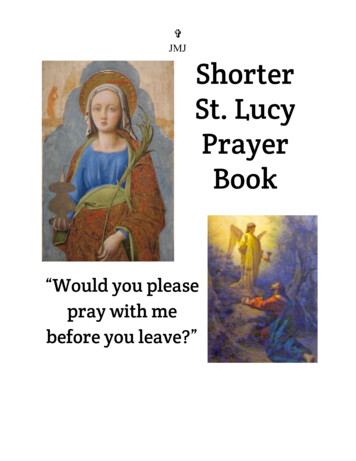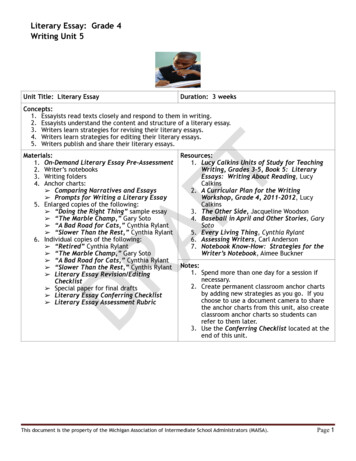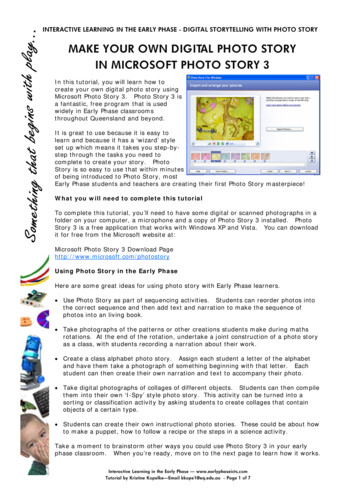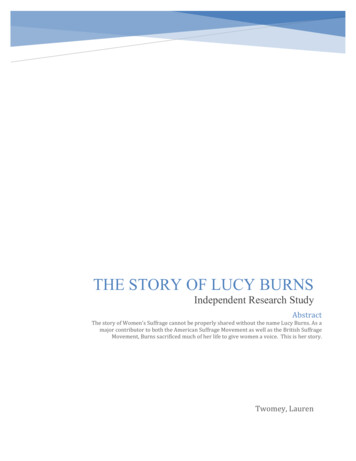
Transcription
THE STORY OF LUCY BURNSIndependent Research StudyAbstractThe story of Women’s Suffrage cannot be properly shared without the name Lucy Burns. As amajor contributor to both the American Suffrage Movement as well as the British SuffrageMovement, Burns sacrificed much of her life to give women a voice. This is her story.Twomey, Lauren
The 1913 Women’s Suffrage March would not have taken place without a number ofinfluential women that contributed their time and efforts into creating “one of the mostimpressively beautiful spectacles ever staged in this country.”1 Early on that March morning, theparade organizers lined up along with five thousand other marchers to walk on PennsylvaniaAvenue advocating for their right to have a larger contribution to society. Often when we hearabout this day, the credit goes to a woman named Alice Paul. One of the main contributors to theMarch who is known as “a vocal leader of the twentieth century women’s suffrage movementwho advocated for the 19th amendment”. 2 Paul was an outstanding activist who fought long andhard for women’s rights in the United States, however she was not alone.While studying social work in England, Paul met Lucy Burns. 3 Burns was born inBrooklyn, New York to an Irish Catholic family.4 Edward Burns, Lucy’s father a bank presidentwanted Lucy to have access to the best education she could receive as a woman at that time.Lucy attended Vassar College where she was “hailed as a brilliant scholar.”5 In England the twowomen were both active members of Emmeline Pankhurst’s Suffragette Movement. Thesewomen participated in hunger strikes and picketing as well as more destructive activitiesincluding “breaking windows, defacing artwork in the National Gallery, and tearing up golfcourses.” 6 Burns was a major contributor and friend to Pankhurst as well as the suffragette1“One of the Most Impressively Beautiful Spectacles Ever Staged in This Country.” New York Times.March 4, 1913.2Michals, Debra. “Alice Paul”, National Women’s History Museum (NWHM), 2015.3Michals, Debra. “Alice Paul”.4Sicherman, Barbara; Green, Carol Hurd (1993). Notable American Women: The Modern Period : aBiographical Dictionary, Volume 4. Cambridge, Mass [u.a.]: Belknap Press of Harvard Univ. Press.pp. 124–125.5Sicherman, Barbara; Green, Carol Hurd (1993). Notable American Women: The Modern Period : aBiographical Dictionary, Volume 4.6Smith, Karen Manners. “Women's Social and Political Union.” Encyclopædia Britannica. EncyclopædiaBritannica, Inc., November 2018.
movement chief organizer Grace Roe. 7 These women really inspired the American suffragistmovement strategies that Burns, and Paul brought back to the states.Burns and Paul both returned to the states following the start of the war for democracybetween England and the US to begin campaigning for women’s right in the states. This is whenmost historians stop talking about Lucy Burns and credit Alice Paul for all the remaining workdone for women’s suffrage. Paul was a major contributor, but Lucy Burns was just as activelyinvolved and responsible for the eventual passing of the 19th amendment. A prime example ofthis lack of coverage can be found on the National Women’s History Museum (NWHM)webpage. If one were to search Lucy Burns there is no specific page for her, and the only truereference to Lucy can be found within Alice Paul’s page where they briefly identified “Paul andBurns join(ing) the National American Women Suffrage Association (NAWSA), with Paulleading the Washington DC chapter”.8This lack of coverage questions Lucy’s contributions to the Women’s SuffrageMovement and leaves Lucy Burn’s role in US suffrage unknown. However, history shows thatBurns played a nearly identical role to Paul but is rarely credited with any of the work shecontributed to the movement. Most of the limited work released on Lucy Burns right now isdefined by her friendship with Alice Paul. In nearly every research database, Lucy Burns comesup under a piece dedicated to Paul. A common trend in how our history is shared. Much of theresearch done on women’s suffrage is on the big names that we identify in our American Historycourses. In the past year, various groups have been working to highlight smaller names involvedin the American Suffrage Movement, such as the National Archives new exhibit dedicated to the7Roe, Grace. “Woman's Hour - Grace Roe - BBC Archive.” BBC News. BBC Audio Files, May 30,2019.8Michals, Debra. “Alice Paul”.
19th Amendment, the Library of Congress releases documents never before seen as they reachtheir 100th year anniversary to the suffrage movement and various authors diving in to identifyother key influencers of various racial and social backgrounds at this time.9 There is substantialevidence that proves that Lucy Burns has been overlooked throughout the history of women’ssuffrage movement. Retelling the story of Women’s Suffrage and including the work of LucyBurns would bring light to her accomplishments, struggles and impact to the women’s suffrageas a whole.With such an amazing career in women’s suffrage, it is incredibly hard to determine thereasoning for the lack of coverage associated with Lucy Burns. A woman who was associatedwith some of the largest pro-woman campaigns and is most commonly noted for her friendshipwith Alice Paul. Alice Paul was an amazing activist. As a woman who has been noted as “thearchitect of some of the most outstanding political achievements on behalf of women in the 20thcentury”, one cannot argue that Paul contributed to the passing of the 19th Amendment and othermonumental steps in women’s suffrage.10 However, Paul could not have done it alone. In nearlyevery scholarly article written about Alice Paul, the author states her close-knit relationship withLucy Burns. PBS did an American Experience piece on Alice Paul that summarizes the mainparts of the Women’s Suffrage Movement in the 1900s. The only problem within this article isthe lack of credit given to Lucy Burns. “Returning home, a radicalized Paul- along with herfriend Lucy Burns” is the only mention to Burns throughout the entire piece. 11 PBS isn’t theonly source to not share Burns role in Women’s Suffrage. In 2009, (later edited in 2018), the9Jessie Kratz, “The Movement as a Mosaic: Alice Paul and Woman Suffrage,” National Archives andRecords Administration (National Archives and Records Administration, May 10, 2019)10Lindman, Janet. “Who Was Alice Paul.” alicepaul.org. Alice Paul Institute, January 2017.11“Alice Paul.” PBS. Public Broadcasting Service, n.d. Accessed December 16, 2019.
History Channel also shared a piece on Alice Paul highlighting the single-handed work Paul haddone for the development that led to ratification of the 19th Amendment. This piece lacked anyreference to Burns and shared all the work Burns’ assisted Paul with as Paul’s own.12 Majorsources are sharing the history of suffrage incorrectly by not telling the story of Lucy Burns. Thisis all many hear about Burns and without diving deeper into research one would never know thatshe played just as much as a role as Alice Paul. In Lucy Burns can be compared to a side-kick ina superhero movie, the person always there to support the leader, who occasionally has theirmoments to shine but is rarely discussed following big events.In the past few years, there has been a push to increase the knowledge around Women’sSuffrage and the 19th Amendment. This past year we celebrated the centennial of the passing ofthe 19th Amendment. With the recent push to educate the public on these historical days, moreundiscovered research has been shared. Many organizations, such as the National Archives inWashington D.C. have created new exhibits to highlight the smaller names associated within thebattle of equal rights between genders. The Rightfully Hers: An American Women and the VoteExhibit opened early this year at the National Archives Museum in D.C.13 The exhibit followsthe road the 19th Amendment took to ratification as well as the individuals that supported itsjourney. However, even within this exhibit there is a lack of mention of Lucy Burns.I bring this exhibition up as I believe the Archives did do a good job of highlighting othersmaller names that played significant roles in women’s suffrage including Mabel Lee, EmilyBarber and Ida B. Wells-Barnett. “The exhibit includes many stories of influential men and12History.com Editors. “Alice Paul.” History.com. A&E Television Networks, November 9, 2009.“Ways to Commemorate the Women's Suffrage Centennial in Washington, DC.” Washington.org.Washington D.C., October 13, 2019.13
women across generations whose persistence made the triumph of the 19th Amendmentpossible”14.Along with the National Archives, many other locations across the country have openedexhibitions that highlight the smaller names of Women’s Suffrage and the battle to the 19thAmendment. “This year, numerous DC museums and institutions are celebrating the 100thanniversary of the passing of the 19th Amendment by Congress on June 4, 1919, which gavewomen the right to vote in the United States for the first time”. 15 The National Portrait Gallery,recently opened their new gallery dedicated to Women’s Suffrage and much to my surprise, theynoted Lucy Burns within the exhibit. Naturally her shout-out came under Alice Paul’s but this isa step forward in the right direction for smaller names to get the exposure they deserve. Bigstrides are taking place outside the city of Washington D.C. as well. Many large organizationslike the American Bar Association have created traveling exhibits to share the history of the 19thAmendment. These exhibits are to move across the country to major cities to spread the historyof the women and men who made the ratification of the 19th Amendment possible. 16The Story of Women’s Suffrage with Lucy BurnsStarting at the beginning, the year was 1879, Madison Square Garden just opened in NewYork City and just over a month later on July 28th, Lucy Burns was born. Burns was the fourth ofeight children in her family, and all who were very bright.17 Inez Haynes Irwin18; a National14Lawerence, Kerri. “Women's Voting Rights Exhibit Opens at National Archives.” National Archivesand Records Administration. National Archives and Records Administration, May 10, 2019.15“Ways to Commemorate the Women's Suffrage Centennial in Washington, DC.” Washington.org.Washington D.C., October 13, 2019.16“19th Amendment Centennial.” 19th Amendment Centennial. American Bar, March 2019.17“Visionaries: Selected Leaders of the National Woman's Party: Articles and Essays: Women ofProtest: Photographs from the Records of the National Woman's Party: Digital Collections: Library ofCongress.” The Library of Congress. LOC. Accessed November 10, 2019.18“Irwin, Inez Haynes.” American Women Writers: A Critical Reference Guide from Colonial Times tothe Present. Encyclopedia.com, December 11, 2019.
Woman’s Party Member sketched Lucy as “blue-eyed and fresh-complexioned; dimpled” younglady.19 Her fire red hair matched her personality and eagerness to fight for what she believed wasright. Irwin also noted that, Lucy’s beauty often led to men of power talking down to her. Lucy’sfather was a banker and his occupation supported the entire family financially.20 Along withproviding substantial funds to the family, Lucy’s father believed education was beneficial andprovided for all his children to be educated. Lucy was very intelligent, which granted her theopportunity to go to Vassar College, New York and then off to graduate school at Yale. At Yale,Lucy did graduate work in linguistics but did not finish her degree instead, Lucy went abroad tostudy at the University of Berlin in Germany from 1906-1908.21 At the University of Berlin,Lucy studied languages then continued her studies at the University of Bonn before eventuallylanding at Oxford University to continue studying linguistics. Again, Lucy did not finish but thistime she left to join her new friend and mentor Emmeline Pankhurst. 22Just within her education, there is so much of Lucy’s story that is overlooked. Lucy waslucky enough to come from a family who believed in women getting an education and she alsoput in work to get into some of the top schools in and out of the country at that time. AttendingYale, Oxford and Vassar is impressive on its own, and that Lucy made a name for herself atthese institutions. At Vassar Lucy dived into a diverse collection of classes including variouslanguage courses, literature arts and economic courses. Lucy was an exemplar student who wascapable of balancing courses that did not correlate with each other. Along with her unique courseselection at Vassar, the Vassar Encyclopedia also notes that Burns was “lauded as gifted student19The Packer Collegiate Institute. “Lucy Burns The Packer Collegiate Institute: A Story of Education inBrooklyn.” Accessed October 25, 2019.20The Packer Collegiate Institute. “Lucy Burns The Packer Collegiate Institute: A Story of Education inBrooklyn.” Accessed October 25, 2019.21“Lucy Burns (1879 – 1966).” Turning Point Suffragist Memorial. Turning Point, March 18, 1970.22“History - Emmeline Pankhurst.” BBC. BBC, September 2017.
by her professors” and at her graduation in 1902 she was the senior spade orator of her class.This long standing tradition is one that is taken with complete seriousness at Vassar. 23Thestudent selected by her peers, professors and mentors to the be the spade orator is responsible forpassing the spade used to break the ground for the construction of the main building by MatthewVassar.24 Although there is no formal record, many other bearers of the spade shared uniquewords with their peers and we can assume the bright and humorous Lucy Burns shared wordswith her class as well. Most research on Lucy also leaves out that she also taught when shewasn’t enrolled in school. For this time period it was odd enough for a woman to earn aneducation but also be hired without full completion of her degrees was nearly unheard of. JudithSargent Murray an early female activist who argued the value in education of in the early yearsof women’s suffrage made it possible for women like Burns to receive a high-quality education.25Lucy was breaking the social standards in almost every way possible for the time period sheresided in. From excelling in some of the top universities at the time, to developing a name forherself in the world of activism and all at such a young age.Emmeline Pankhurst’s Influence on LucyThe work she did for women’s rights was the most prevalent and how most would relateher to. As previously stated, when Lucy was still an Oxford student studying abroad, she metEmmeline Pankhurst. Pankhurst was a co-founder and leader of the Women’s Social and23Chiara, Judith L. “Lucy Burns.” Lucy Burns - Vassar College Encyclopedia - Vassar College. VassarCollege Encyclopedia, n.d. Accessed October 15, 2019.24Chiara, Judith L. “Lucy Burns.” Lucy Burns - Vassar College Encyclopedia - Vassar College. VassarCollege Encyclopedia, n.d. Accessed October 15, 2019.25“Judith Sargent Murray Quotes from Essays and Letters.” jsmsociety. Hurd Smith Communications,2019. http://jsmsociety.com/Quotes.html.
Political Union (WSPU) and also founded the Women’s Franchise League that advocated formarried women to have a vote in local elections. 26The WSPU was notable for its “suffragettes”;the main supporters and contributors to the group were known for their unladylike activismstrategies. Emmeline herself was arrested various times throughout her activism career and wassteadfastly persistent. It was Pankhurst who participated in the hunger strike (like the one AlicePaul and Lucy Burns later took part in the United States) that led to the ‘Cat and Mouse’ Act. 27This act was created to keep women alive who were actively starving themselves to prove apoint. 28If a women was viewed as malnourished or significantly ill due to lack of food intake,rather than force feed them (which was causing more societal debates), the women would beremoved from prison until her health recovered to a normal state, so she could finish hersentencing. This radical way of protesting created a large scene against the British Parliamentwho had no other opportunity than to address the problem at hand.It was the deep-seated strong activism Emmeline Pankhurst ran that inspired a youngAlice Paul and Lucy Burns.29 Within Lucy you see the strongminded Pankhurst styled approachto activism brought to the United States. Alice Paul and Lucy Burns were in a London policestation when they met, little did they know they were soon to be founders of the National26“History - Emmeline Pankhurst.” BBC. BBC, September 2017.“Prisoners (Temporary Discharge for Ill-Health Act, 1913”. Chapter 4. April 25, 2918. December,2019. Accessed from n-forcefeeding/cat-and-mouse-act/28“Prisoners (Temporary Discharge for Ill-Health Act, 1913”. Chapter 4. April 25, 2918. December,2019. Accessed from n-forcefeeding/cat-and-mouse-act/2729Lucy Burns (1879 – 1966).” Turning Point Suffragist Memorial. Turning Point, March 18, 1970.
Women’s Party. 30 Before returning home Lucy was awarded “for her suffrage activism as acolleague of Emmeline and Christabel Pankhurst; she was awarded a special medal from theWSPU for her bravery in the course of several arrests and prison hunger strikes”. 31Lucy Burns returned to the United States after completing some work with Pankhurst andPaul in 1912. Alice and Lucy immediately linked back up together when they both returned tothe US. At this time, the presidential election was coming to a close and Woodrow Wilson hadbeen elected and was soon to be inaugurated.32 Burns and Paul began to advocate for anamendment to guarantee women the right to vote. This wasn’t the first debate for a woman’sright to vote, but arguably the most radical. When the “right to vote” was put in place in 1789, itonly guaranteed white males who owned property the “right to vote.” 33 Women immediatelybegan advocating for their “right to vote” and the earlier work by women like Abigail Adams,Elizabeth Cady Stanton and many others inspired women like Alice Paul and Lucy Burns.In 1913, we see a significant drive in women’s rights advocacy. Throughout much ofAmerican History, women advocated for their rights but were often put on hold, when otherlarger events occurred. However, this time, the big event was the women. With a large following,including both men and women we see a significant jump in the number of women advocacy30Mary Ware Dennett to Alice Paul, 3 February 1913, and Anna Howard Shaw to Alice Paul, 5 March1913, National Woman’s Party Records, Group I, Manuscript Division, Library of Congress. Linda G.Ford, Iron Jawed Angels: The Suffrage Militancy of the National Woman’s Party, 1912-1920 (Lanham,MD.: University Press of America, 1991), 3. Received -protest/images/history.pdf31Adams, Jad. 2014. “We Will Fight for You!” History Today64 (9): ect true&AuthType ip,sso&db 30h&AN 98365337&site ehost-live&scope site.32History.com Editors. “Woodrow Wilson.” History.com. A&E Television Networks, October 29, woodrow-wilson.33US Legal, Inc. “Voting Rights.” Civil Rights. US Legal, n.d. Accessed December 2019.
events. To begin, we have two of the biggest radical advocates (Alice and Lucy) back in theUnited States stirring the pot in every way possible. 34 Many other female suffragists at the timedid not approve of the radical approach Burns and Paul took. Carrie Chapman Catt (President ofthe National American Women’s Suffrage Association: NAWSA) wrote in a letter to Lucy Burnsto express her distastefulness in the NWP and the management Paul and Burns led. Catt stated“You may think we are all a set of old fogies and perhaps we are, but I, for one, thank heaventhat I am as much of an old fogy as I am It requires a good deal more courage to work steadilyand steadfastly for 40 or 50 years to gain an end than it does to do an impulsively rash thing andlose it.”35 Catt and Paul were not friends but contenders; they promoted the same solutions buthad very different ways of achieving their goals. Catt believed that the focus of advocating forwomen’s suffrage as a whole would be more beneficial than just protesting for the addition of anew amendment. Catt led the NAWSA which main focus was leading women in their support towar efforts. 36As Paul moved out of work with the NAWSA, she (with the help of Burns) beganher work towards developing a party that would allow women to protest radically.While advocating for the addition of a new constitutional amendment that would grantwomen the right to vote they worked to create the National Women’s Party. The NWP “built amembership of a committed supporters that mobilized across the country in support of women’ssuffrage (by) protesting, marching and organizing events to advance women’s rights”. 37 TheNWP advocated for equality to be granted by our constitution for all women and drafted the34“Mission Statement.” National Women's Party. National Women's Party, n.d. Accessed September 30,2019.35“Lucy Burns (U.S. National Park Service).” National Parks Service. U.S. Department of the Interior,August 30, 2019.36Lumsden, Linda J. Rampant Women: The Role of the Right to Peaceably Assemble in the WomanSuffrage Movement, 1908-1919. 1st ed. Knoxville, TN: University of Tennessee Press, 1995. 232-24037“Mission Statement.” National Women's Party. National Women's Party, n.d. Accessed September 30,2019.
Equal Rights Amendment (ERA). The ERA “is a proposed amendment to the United Statesdesigned to guarantee equal right for all American citizens regardless of sex.” 38 This amendmenthas yet to be passed but has been ratified by thirty-seven of the fifty states. This discussion forthe rights that would be granted within the amendment were originally introduced at the SenecaFalls Woman’s Rights Convention by Elizabeth Cady Stanton. We see it reintroduced severaltimes throughout history including when Alice Paul and Lucy Burns created an argumentsupporting its ratification. Both the women were active in creating various political campaignsthat were seen as “out of the norm.” While Paul, continued to work in direct advocacy, Lucybegan her work with The Suffragist editing various articles covering Women’s Suffrage. AliceBurns is credited with the creation of The Suffragist, but without Lucy’s editing skills the bulletinwould never have been completed. Lucy served as the main editor until 1917, when the positionwas taken over by Houghton Hooker (who had previously been the editor of the MarylandSuffrage News.) 39The Suffragist was originally supposed to serve as a journal but it was in competitionwith the “Women’s Journal”. As Lucy and Alice worked to develop their new political party TheSuffragist served as a voice for all women battling for their rights. The first bulletin was releasedon November 15th, 1913 and was in direct connection with the Congressional Union for WomanSuffrage. 40The CUWS was an organization founded by Alice and Lucy to campaign forAmerican women’s suffrage by prompting a constitutional amendment. This organization was38“Did You Know? Alice Paul Versus Carrie Chapman Catt (U.S. National Park Service).” NationalParks Service. U.S. Department of the Interior, 20, 2019.39Dolton, Tisha, Sally Lisk-Lewis, Tammy White, Caitlyn, Theresa Lanning, Joe DeFilippo, TraceyTofield, and Denise. “Woman Suffrage Memorabilia: Suffrage Journals.” Woman Suffrage Memorabilia.WSM. Accessed November 18, 2019.40Marin Journal, Volume 53, Number 36, 9 September 1915. Accessed on December 8, 2019.
inspired by the United Kingdom’s Suffragette Party that believed in “deeds, not words.”41 Wesee this demonstrated in the First World War, when these women participated in Hunger Strikesand chained themselves outside buildings to protest. The most memorable event that resulted in afatality occurred at the Epsom Derby in 1913, when Suffragette Emily Wilding Davison steppedout in front of the King’s Horse. This brought a significant amount of attention to theSuffragettes and mass crowds to her funeral procession. 42 It was compelling events like this thatbuilt up the angst that came along with women’s suffrage and were often cited throughout TheSuffragist.The women did not stop here, in April of 1914, Lucy was serving as the NWP LegislativeChairman in Washington D.C. and was still actively editing The Suffragist as well. 4344 Burns hasbeen credited as the driving force behind the picketing of Woodrow Wilson’s administration inD.C. 45 It was her attitude that angered many American’s that opposed women’s suffrage. AsLucy continued her activism in Washington, she worked with many other lesser known activists.For example, in the summer of 1917 Lucy Burns discovered that a group of Russian envoys (arepresentative of a government who is sent on a special diplomatic mission) would be in town to41Haynes, Suyin. “British Women's Suffragette Movement: 100 Years of Lessons.” Time. Time,February 8, 2018. Accessed ender?data &vid 0&sid 0642“Emily Davison Laid to Rest.” Emily Davison laid to rest Century Ireland. Century Ireland, June 15,1913. Accessed November 5, 2019.43Clinedinst Studio, Washington, D.C. Lucy Burns, Vice Chairman Congressional Union. United StatesWashington D.C, 1913. Photograph. https://www.loc.gov/item/mnwp000096/.44Lucy Burns (1879 – 1966).” Turning Point Suffragist Memorial. Turning Point, March 18, 1970.45“Visionaries: Selected Leaders of the National Woman's Party: Articles and Essays: Women ofProtest: Photographs from the Records of the National Woman's Party: Digital Collections: Library ofCongress.” The Library of Congress. COLLECTION Women of Protest: Photographs from the Recordsof the National Woman's Party, n.d. Accessed October 9, 2019.
discuss the recent Russian Revolutions that had taken place. 46 Lucy and fellow activist DoraLewis; a member of the National Women’s who served as “a member of the National Women’sParty executive committee, chairman of the finance committee, national treasurer, andratification committee chairman” picketed outside the White House. 47 The sign they held stated“To the Envoys of Russia. President Wilson and Envoy Root are deceiving Russia. They say weare a democracy. Help us win a war so that democracies may survive. We the Women ofAmerica are denied the right to vote. President Wilson is the chief opponent of their nationalenfranchisement. Help us make this nation really free. Tell our government it must liberate itspeople before it can claim free Russia as an ally”. 48 This protest that blatantly called outAmerica for being an unequal democracy wasn’t the first radical protest Lucy had participated inand it wouldn’t be the last either. Not even a month later Lucy was protesting again inWashington with Katharine A. Morey. Morey, a Massachusetts NWP representative is mostfamously known for being a state chairman that introduced the Woman’s Party Bill for EqualRights. She worked closely to politics as an election campaigner in Kansas (1916) but found herway to Washington to picket with Lucy Burns. Again, we found Lucy picketing outside theWhite House (stopping street traffic). This was the first picketing of many outside the whitehouse that led to an arrest. 49 Both served three days in jail for their actions outside the White46“Envoy.” Merriam-Webster. Merriam-Webster, n.d. Accessed November 27, 2019.“Irwin, Inez Haynes.” American Women Writers: A Critical Reference Guide from Colonial Times tothe Present. Encyclopedia.com, December 11, 2019.48Harris & Ewing, photographer. To the Envoys of Russia. President Wilson and Envoy Root aredeceiving Russia. They say we are a democracy. Help us win a world war so that democracies maysurvive. We, the Women of America tell you that America is not a democracy. United States United States,1917. Photograph. https://www.loc.gov/item/2016884713/.49“1917: Historical Timeline of the National Womans Party: Articles and Essays: Women of Protest:Photographs from the Records of the National Woman's Party: Digital Collections: Library ofCongress.” The Library of Congress. COLLECTION Women of Protest: Photographs from the Recordsof the National Woman's Party, n.d. Accessed October 12, 2019.47
House. It is believed that President Wilson was extremely frustrated by this protest which thenpushed the Administration to respond.Inside the Jail Cell“Burns was arrested and imprisoned six times”. 50 She served more jail time than anyother American suffragist. The women at this time believed to serve jail time more as positivereflection of their work and a step in the right direction. One unnamed suffragist said “Not tohave been willing to endure the gloom of prison would have made moral slackers of all”.51 Burnsactions were just as radical as Emmeline Pankhurst who even came to support Alice and Lucy’sfight on Washington following their work together in England.52 Burns was arrested in June of1917, after leading the most picketing demonstration in front of the White House(she wassentenced for three days). 53 In September of the same year she was sentenced (this time to sixtydays) for protesting the presidential electio
movement strategies that Burns, and Paul brought back to the states. Burns and Paul both returned to the states following the start of the war for democracy between England and the US to begin campaigning for women's right in the states. This is when most historians stop talking about Lucy Burns and credit Alice Paul for all the remaining work


